Business Finance Report: Working Capital, Budgeting and Cash Flow
VerifiedAdded on 2023/01/12
|10
|3073
|49
Report
AI Summary
This report delves into the core concepts of business finance, examining working capital management, budgeting techniques, and their impact on cash flow and financial results. Part 1 focuses on the definition of business finance, profit, cash flow, working capital, inventory, payables, and receivables. It explores the effects of changes in working capital on cash flows and the impact of management decisions on a company's financial performance, using Mediterranean Delights Ltd as a case study. Part 2 shifts the focus to budgeting, defining its objectives and comparing traditional budgeting with alternative methods such as zero-based and rolling budgets. The report analyzes the application of these budgeting methods for cost management, providing a comparative analysis of their advantages and disadvantages. The report aims to enhance the understanding of working capital and budgeting within a business context.
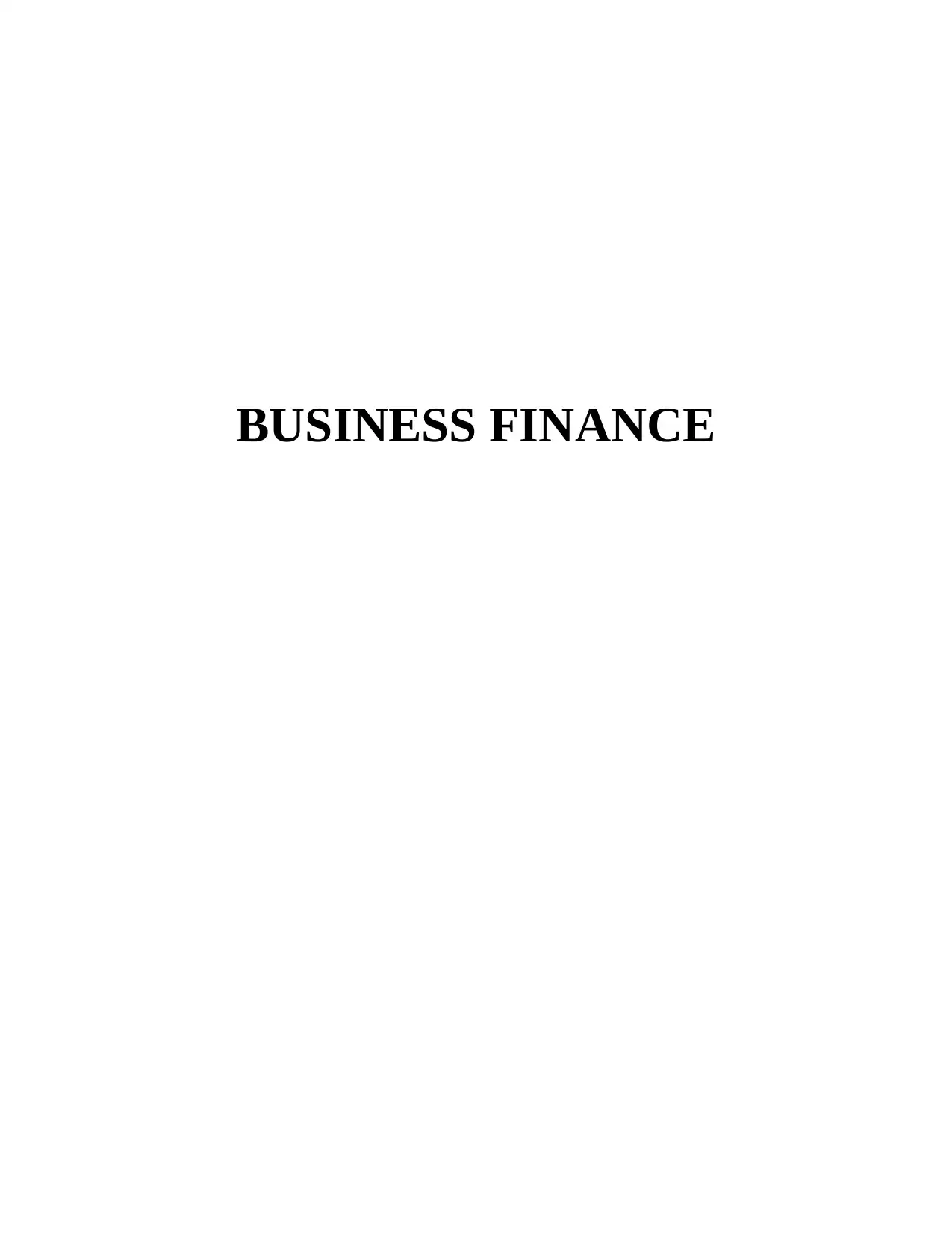
BUSINESS FINANCE
Paraphrase This Document
Need a fresh take? Get an instant paraphrase of this document with our AI Paraphraser
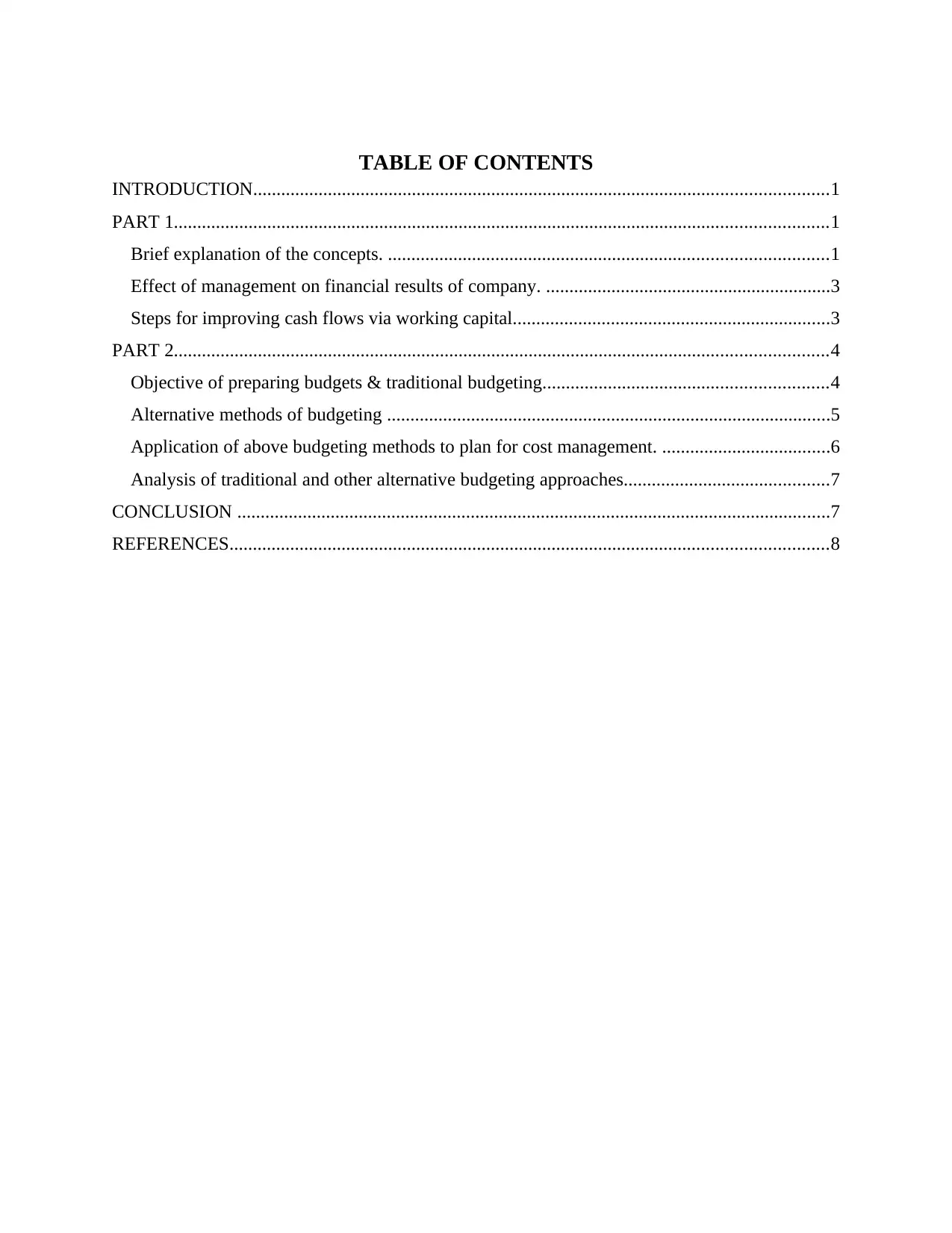
TABLE OF CONTENTS
INTRODUCTION...........................................................................................................................1
PART 1............................................................................................................................................1
Brief explanation of the concepts. ..............................................................................................1
Effect of management on financial results of company. .............................................................3
Steps for improving cash flows via working capital....................................................................3
PART 2............................................................................................................................................4
Objective of preparing budgets & traditional budgeting.............................................................4
Alternative methods of budgeting ...............................................................................................5
Application of above budgeting methods to plan for cost management. ....................................6
Analysis of traditional and other alternative budgeting approaches............................................7
CONCLUSION ...............................................................................................................................7
REFERENCES................................................................................................................................8
INTRODUCTION...........................................................................................................................1
PART 1............................................................................................................................................1
Brief explanation of the concepts. ..............................................................................................1
Effect of management on financial results of company. .............................................................3
Steps for improving cash flows via working capital....................................................................3
PART 2............................................................................................................................................4
Objective of preparing budgets & traditional budgeting.............................................................4
Alternative methods of budgeting ...............................................................................................5
Application of above budgeting methods to plan for cost management. ....................................6
Analysis of traditional and other alternative budgeting approaches............................................7
CONCLUSION ...............................................................................................................................7
REFERENCES................................................................................................................................8
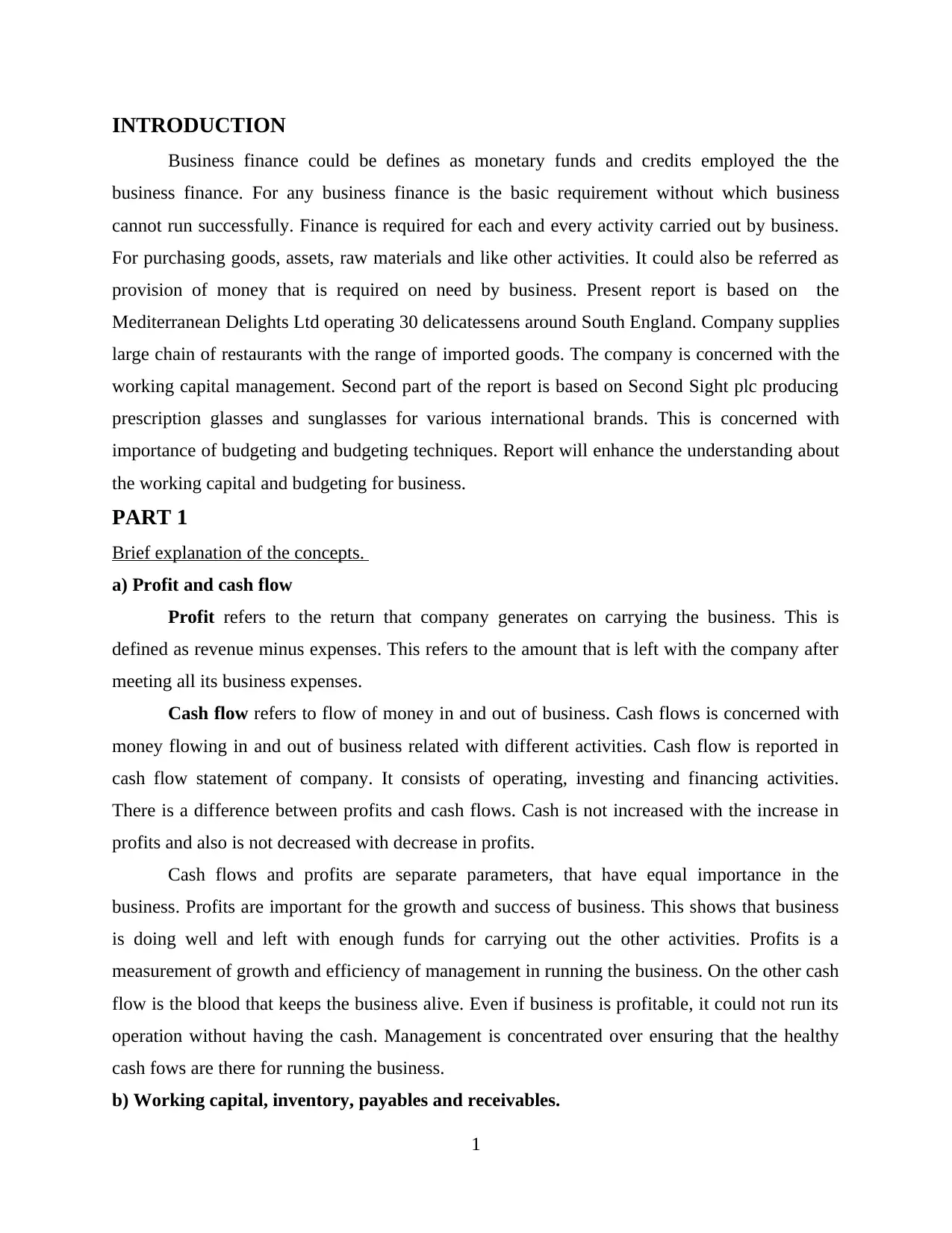
INTRODUCTION
Business finance could be defines as monetary funds and credits employed the the
business finance. For any business finance is the basic requirement without which business
cannot run successfully. Finance is required for each and every activity carried out by business.
For purchasing goods, assets, raw materials and like other activities. It could also be referred as
provision of money that is required on need by business. Present report is based on the
Mediterranean Delights Ltd operating 30 delicatessens around South England. Company supplies
large chain of restaurants with the range of imported goods. The company is concerned with the
working capital management. Second part of the report is based on Second Sight plc producing
prescription glasses and sunglasses for various international brands. This is concerned with
importance of budgeting and budgeting techniques. Report will enhance the understanding about
the working capital and budgeting for business.
PART 1
Brief explanation of the concepts.
a) Profit and cash flow
Profit refers to the return that company generates on carrying the business. This is
defined as revenue minus expenses. This refers to the amount that is left with the company after
meeting all its business expenses.
Cash flow refers to flow of money in and out of business. Cash flows is concerned with
money flowing in and out of business related with different activities. Cash flow is reported in
cash flow statement of company. It consists of operating, investing and financing activities.
There is a difference between profits and cash flows. Cash is not increased with the increase in
profits and also is not decreased with decrease in profits.
Cash flows and profits are separate parameters, that have equal importance in the
business. Profits are important for the growth and success of business. This shows that business
is doing well and left with enough funds for carrying out the other activities. Profits is a
measurement of growth and efficiency of management in running the business. On the other cash
flow is the blood that keeps the business alive. Even if business is profitable, it could not run its
operation without having the cash. Management is concentrated over ensuring that the healthy
cash fows are there for running the business.
b) Working capital, inventory, payables and receivables.
1
Business finance could be defines as monetary funds and credits employed the the
business finance. For any business finance is the basic requirement without which business
cannot run successfully. Finance is required for each and every activity carried out by business.
For purchasing goods, assets, raw materials and like other activities. It could also be referred as
provision of money that is required on need by business. Present report is based on the
Mediterranean Delights Ltd operating 30 delicatessens around South England. Company supplies
large chain of restaurants with the range of imported goods. The company is concerned with the
working capital management. Second part of the report is based on Second Sight plc producing
prescription glasses and sunglasses for various international brands. This is concerned with
importance of budgeting and budgeting techniques. Report will enhance the understanding about
the working capital and budgeting for business.
PART 1
Brief explanation of the concepts.
a) Profit and cash flow
Profit refers to the return that company generates on carrying the business. This is
defined as revenue minus expenses. This refers to the amount that is left with the company after
meeting all its business expenses.
Cash flow refers to flow of money in and out of business. Cash flows is concerned with
money flowing in and out of business related with different activities. Cash flow is reported in
cash flow statement of company. It consists of operating, investing and financing activities.
There is a difference between profits and cash flows. Cash is not increased with the increase in
profits and also is not decreased with decrease in profits.
Cash flows and profits are separate parameters, that have equal importance in the
business. Profits are important for the growth and success of business. This shows that business
is doing well and left with enough funds for carrying out the other activities. Profits is a
measurement of growth and efficiency of management in running the business. On the other cash
flow is the blood that keeps the business alive. Even if business is profitable, it could not run its
operation without having the cash. Management is concentrated over ensuring that the healthy
cash fows are there for running the business.
b) Working capital, inventory, payables and receivables.
1
You're viewing a preview
Unlock full access by subscribing today!
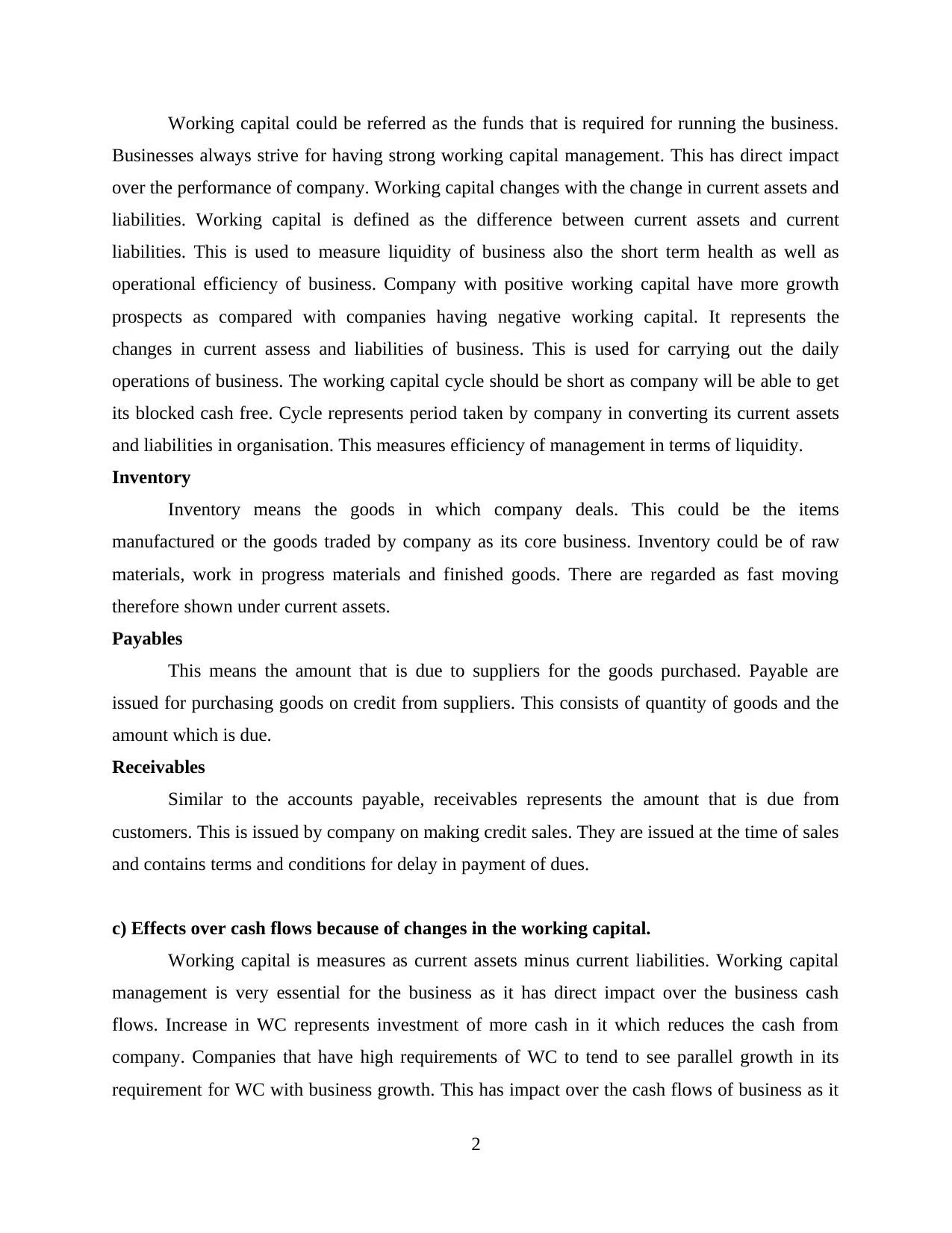
Working capital could be referred as the funds that is required for running the business.
Businesses always strive for having strong working capital management. This has direct impact
over the performance of company. Working capital changes with the change in current assets and
liabilities. Working capital is defined as the difference between current assets and current
liabilities. This is used to measure liquidity of business also the short term health as well as
operational efficiency of business. Company with positive working capital have more growth
prospects as compared with companies having negative working capital. It represents the
changes in current assess and liabilities of business. This is used for carrying out the daily
operations of business. The working capital cycle should be short as company will be able to get
its blocked cash free. Cycle represents period taken by company in converting its current assets
and liabilities in organisation. This measures efficiency of management in terms of liquidity.
Inventory
Inventory means the goods in which company deals. This could be the items
manufactured or the goods traded by company as its core business. Inventory could be of raw
materials, work in progress materials and finished goods. There are regarded as fast moving
therefore shown under current assets.
Payables
This means the amount that is due to suppliers for the goods purchased. Payable are
issued for purchasing goods on credit from suppliers. This consists of quantity of goods and the
amount which is due.
Receivables
Similar to the accounts payable, receivables represents the amount that is due from
customers. This is issued by company on making credit sales. They are issued at the time of sales
and contains terms and conditions for delay in payment of dues.
c) Effects over cash flows because of changes in the working capital.
Working capital is measures as current assets minus current liabilities. Working capital
management is very essential for the business as it has direct impact over the business cash
flows. Increase in WC represents investment of more cash in it which reduces the cash from
company. Companies that have high requirements of WC to tend to see parallel growth in its
requirement for WC with business growth. This has impact over the cash flows of business as it
2
Businesses always strive for having strong working capital management. This has direct impact
over the performance of company. Working capital changes with the change in current assets and
liabilities. Working capital is defined as the difference between current assets and current
liabilities. This is used to measure liquidity of business also the short term health as well as
operational efficiency of business. Company with positive working capital have more growth
prospects as compared with companies having negative working capital. It represents the
changes in current assess and liabilities of business. This is used for carrying out the daily
operations of business. The working capital cycle should be short as company will be able to get
its blocked cash free. Cycle represents period taken by company in converting its current assets
and liabilities in organisation. This measures efficiency of management in terms of liquidity.
Inventory
Inventory means the goods in which company deals. This could be the items
manufactured or the goods traded by company as its core business. Inventory could be of raw
materials, work in progress materials and finished goods. There are regarded as fast moving
therefore shown under current assets.
Payables
This means the amount that is due to suppliers for the goods purchased. Payable are
issued for purchasing goods on credit from suppliers. This consists of quantity of goods and the
amount which is due.
Receivables
Similar to the accounts payable, receivables represents the amount that is due from
customers. This is issued by company on making credit sales. They are issued at the time of sales
and contains terms and conditions for delay in payment of dues.
c) Effects over cash flows because of changes in the working capital.
Working capital is measures as current assets minus current liabilities. Working capital
management is very essential for the business as it has direct impact over the business cash
flows. Increase in WC represents investment of more cash in it which reduces the cash from
company. Companies that have high requirements of WC to tend to see parallel growth in its
requirement for WC with business growth. This has impact over the cash flows of business as it
2
Paraphrase This Document
Need a fresh take? Get an instant paraphrase of this document with our AI Paraphraser
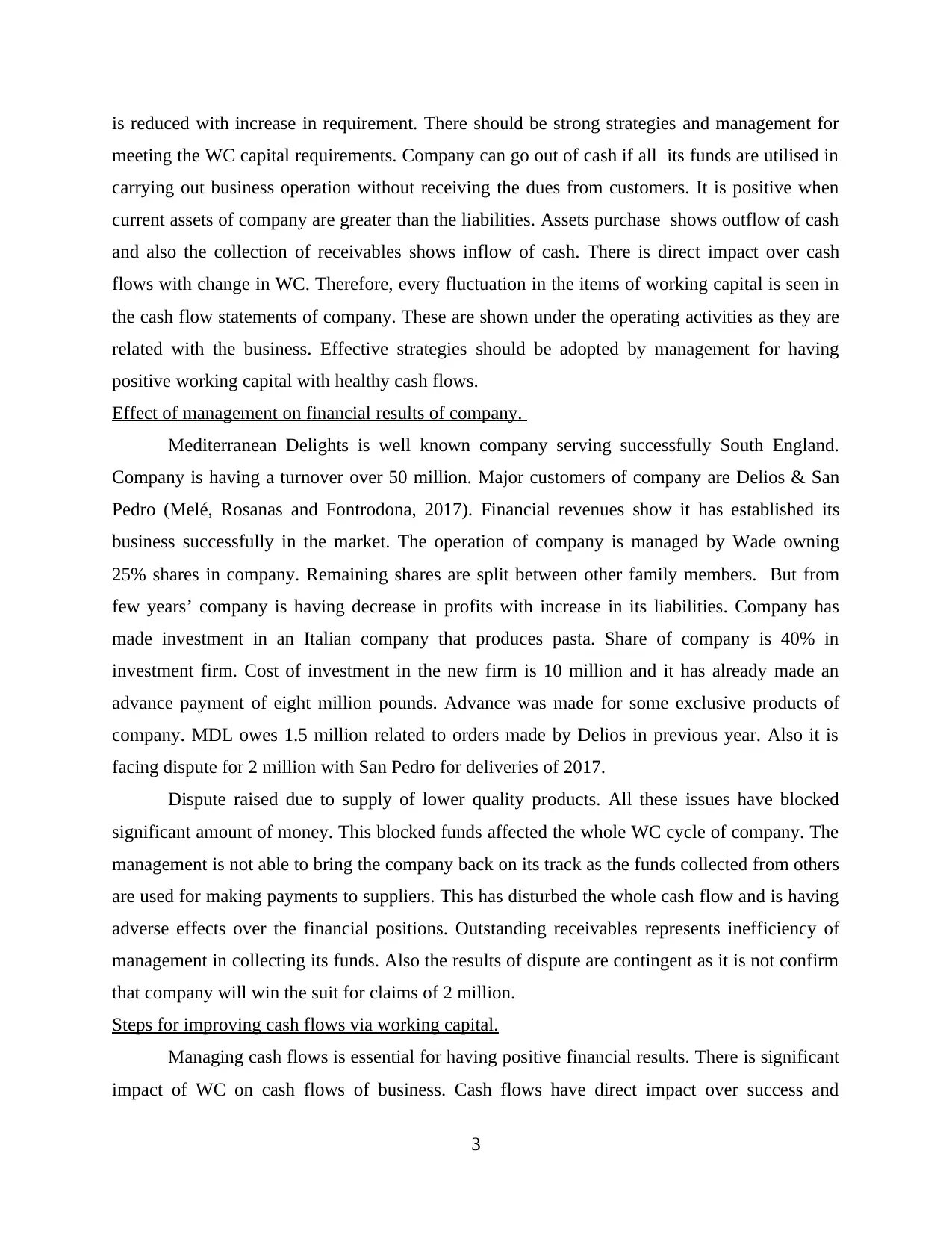
is reduced with increase in requirement. There should be strong strategies and management for
meeting the WC capital requirements. Company can go out of cash if all its funds are utilised in
carrying out business operation without receiving the dues from customers. It is positive when
current assets of company are greater than the liabilities. Assets purchase shows outflow of cash
and also the collection of receivables shows inflow of cash. There is direct impact over cash
flows with change in WC. Therefore, every fluctuation in the items of working capital is seen in
the cash flow statements of company. These are shown under the operating activities as they are
related with the business. Effective strategies should be adopted by management for having
positive working capital with healthy cash flows.
Effect of management on financial results of company.
Mediterranean Delights is well known company serving successfully South England.
Company is having a turnover over 50 million. Major customers of company are Delios & San
Pedro (Melé, Rosanas and Fontrodona, 2017). Financial revenues show it has established its
business successfully in the market. The operation of company is managed by Wade owning
25% shares in company. Remaining shares are split between other family members. But from
few years’ company is having decrease in profits with increase in its liabilities. Company has
made investment in an Italian company that produces pasta. Share of company is 40% in
investment firm. Cost of investment in the new firm is 10 million and it has already made an
advance payment of eight million pounds. Advance was made for some exclusive products of
company. MDL owes 1.5 million related to orders made by Delios in previous year. Also it is
facing dispute for 2 million with San Pedro for deliveries of 2017.
Dispute raised due to supply of lower quality products. All these issues have blocked
significant amount of money. This blocked funds affected the whole WC cycle of company. The
management is not able to bring the company back on its track as the funds collected from others
are used for making payments to suppliers. This has disturbed the whole cash flow and is having
adverse effects over the financial positions. Outstanding receivables represents inefficiency of
management in collecting its funds. Also the results of dispute are contingent as it is not confirm
that company will win the suit for claims of 2 million.
Steps for improving cash flows via working capital.
Managing cash flows is essential for having positive financial results. There is significant
impact of WC on cash flows of business. Cash flows have direct impact over success and
3
meeting the WC capital requirements. Company can go out of cash if all its funds are utilised in
carrying out business operation without receiving the dues from customers. It is positive when
current assets of company are greater than the liabilities. Assets purchase shows outflow of cash
and also the collection of receivables shows inflow of cash. There is direct impact over cash
flows with change in WC. Therefore, every fluctuation in the items of working capital is seen in
the cash flow statements of company. These are shown under the operating activities as they are
related with the business. Effective strategies should be adopted by management for having
positive working capital with healthy cash flows.
Effect of management on financial results of company.
Mediterranean Delights is well known company serving successfully South England.
Company is having a turnover over 50 million. Major customers of company are Delios & San
Pedro (Melé, Rosanas and Fontrodona, 2017). Financial revenues show it has established its
business successfully in the market. The operation of company is managed by Wade owning
25% shares in company. Remaining shares are split between other family members. But from
few years’ company is having decrease in profits with increase in its liabilities. Company has
made investment in an Italian company that produces pasta. Share of company is 40% in
investment firm. Cost of investment in the new firm is 10 million and it has already made an
advance payment of eight million pounds. Advance was made for some exclusive products of
company. MDL owes 1.5 million related to orders made by Delios in previous year. Also it is
facing dispute for 2 million with San Pedro for deliveries of 2017.
Dispute raised due to supply of lower quality products. All these issues have blocked
significant amount of money. This blocked funds affected the whole WC cycle of company. The
management is not able to bring the company back on its track as the funds collected from others
are used for making payments to suppliers. This has disturbed the whole cash flow and is having
adverse effects over the financial positions. Outstanding receivables represents inefficiency of
management in collecting its funds. Also the results of dispute are contingent as it is not confirm
that company will win the suit for claims of 2 million.
Steps for improving cash flows via working capital.
Managing cash flows is essential for having positive financial results. There is significant
impact of WC on cash flows of business. Cash flows have direct impact over success and
3
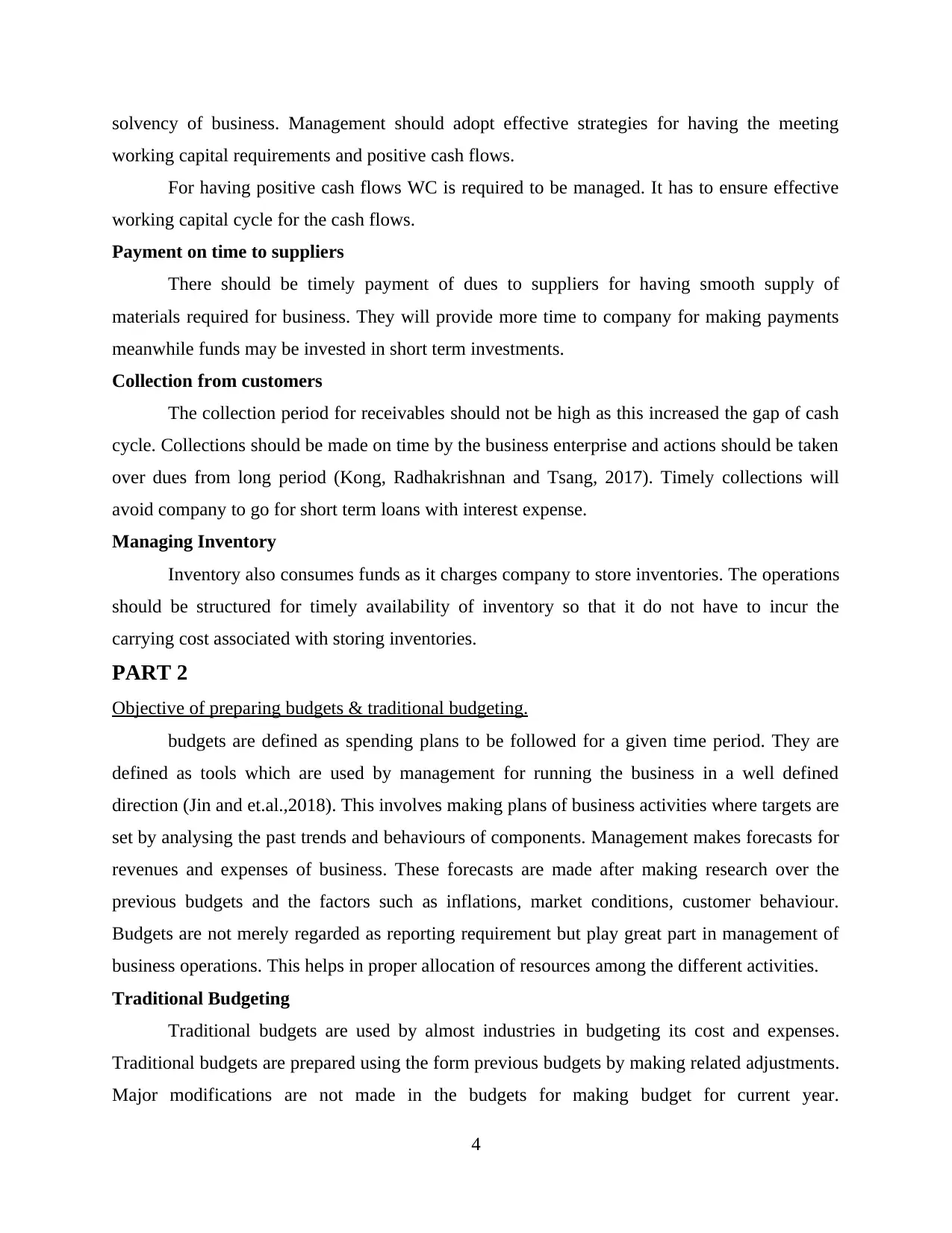
solvency of business. Management should adopt effective strategies for having the meeting
working capital requirements and positive cash flows.
For having positive cash flows WC is required to be managed. It has to ensure effective
working capital cycle for the cash flows.
Payment on time to suppliers
There should be timely payment of dues to suppliers for having smooth supply of
materials required for business. They will provide more time to company for making payments
meanwhile funds may be invested in short term investments.
Collection from customers
The collection period for receivables should not be high as this increased the gap of cash
cycle. Collections should be made on time by the business enterprise and actions should be taken
over dues from long period (Kong, Radhakrishnan and Tsang, 2017). Timely collections will
avoid company to go for short term loans with interest expense.
Managing Inventory
Inventory also consumes funds as it charges company to store inventories. The operations
should be structured for timely availability of inventory so that it do not have to incur the
carrying cost associated with storing inventories.
PART 2
Objective of preparing budgets & traditional budgeting.
budgets are defined as spending plans to be followed for a given time period. They are
defined as tools which are used by management for running the business in a well defined
direction (Jin and et.al.,2018). This involves making plans of business activities where targets are
set by analysing the past trends and behaviours of components. Management makes forecasts for
revenues and expenses of business. These forecasts are made after making research over the
previous budgets and the factors such as inflations, market conditions, customer behaviour.
Budgets are not merely regarded as reporting requirement but play great part in management of
business operations. This helps in proper allocation of resources among the different activities.
Traditional Budgeting
Traditional budgets are used by almost industries in budgeting its cost and expenses.
Traditional budgets are prepared using the form previous budgets by making related adjustments.
Major modifications are not made in the budgets for making budget for current year.
4
working capital requirements and positive cash flows.
For having positive cash flows WC is required to be managed. It has to ensure effective
working capital cycle for the cash flows.
Payment on time to suppliers
There should be timely payment of dues to suppliers for having smooth supply of
materials required for business. They will provide more time to company for making payments
meanwhile funds may be invested in short term investments.
Collection from customers
The collection period for receivables should not be high as this increased the gap of cash
cycle. Collections should be made on time by the business enterprise and actions should be taken
over dues from long period (Kong, Radhakrishnan and Tsang, 2017). Timely collections will
avoid company to go for short term loans with interest expense.
Managing Inventory
Inventory also consumes funds as it charges company to store inventories. The operations
should be structured for timely availability of inventory so that it do not have to incur the
carrying cost associated with storing inventories.
PART 2
Objective of preparing budgets & traditional budgeting.
budgets are defined as spending plans to be followed for a given time period. They are
defined as tools which are used by management for running the business in a well defined
direction (Jin and et.al.,2018). This involves making plans of business activities where targets are
set by analysing the past trends and behaviours of components. Management makes forecasts for
revenues and expenses of business. These forecasts are made after making research over the
previous budgets and the factors such as inflations, market conditions, customer behaviour.
Budgets are not merely regarded as reporting requirement but play great part in management of
business operations. This helps in proper allocation of resources among the different activities.
Traditional Budgeting
Traditional budgets are used by almost industries in budgeting its cost and expenses.
Traditional budgets are prepared using the form previous budgets by making related adjustments.
Major modifications are not made in the budgets for making budget for current year.
4
You're viewing a preview
Unlock full access by subscribing today!
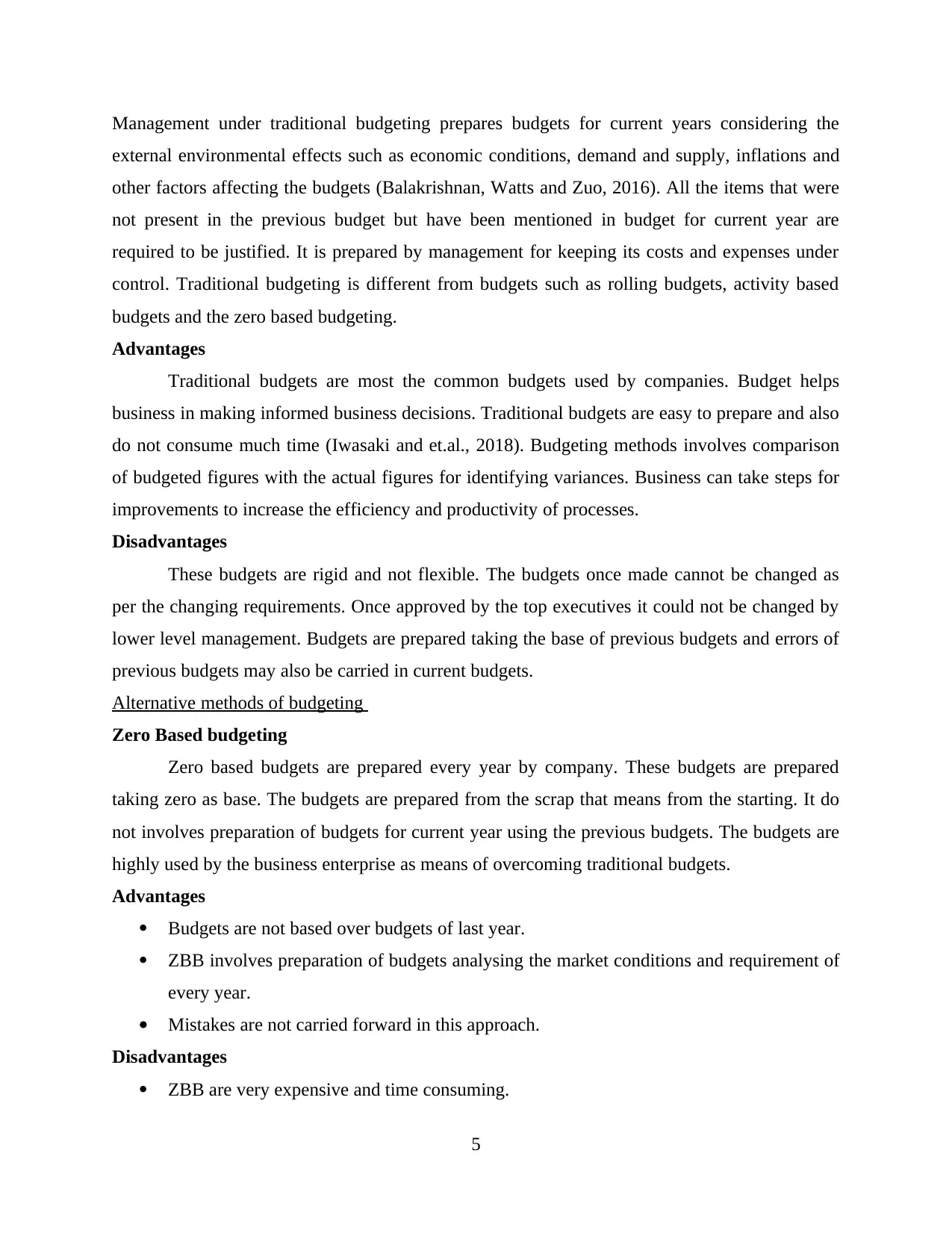
Management under traditional budgeting prepares budgets for current years considering the
external environmental effects such as economic conditions, demand and supply, inflations and
other factors affecting the budgets (Balakrishnan, Watts and Zuo, 2016). All the items that were
not present in the previous budget but have been mentioned in budget for current year are
required to be justified. It is prepared by management for keeping its costs and expenses under
control. Traditional budgeting is different from budgets such as rolling budgets, activity based
budgets and the zero based budgeting.
Advantages
Traditional budgets are most the common budgets used by companies. Budget helps
business in making informed business decisions. Traditional budgets are easy to prepare and also
do not consume much time (Iwasaki and et.al., 2018). Budgeting methods involves comparison
of budgeted figures with the actual figures for identifying variances. Business can take steps for
improvements to increase the efficiency and productivity of processes.
Disadvantages
These budgets are rigid and not flexible. The budgets once made cannot be changed as
per the changing requirements. Once approved by the top executives it could not be changed by
lower level management. Budgets are prepared taking the base of previous budgets and errors of
previous budgets may also be carried in current budgets.
Alternative methods of budgeting
Zero Based budgeting
Zero based budgets are prepared every year by company. These budgets are prepared
taking zero as base. The budgets are prepared from the scrap that means from the starting. It do
not involves preparation of budgets for current year using the previous budgets. The budgets are
highly used by the business enterprise as means of overcoming traditional budgets.
Advantages
Budgets are not based over budgets of last year.
ZBB involves preparation of budgets analysing the market conditions and requirement of
every year.
Mistakes are not carried forward in this approach.
Disadvantages
ZBB are very expensive and time consuming.
5
external environmental effects such as economic conditions, demand and supply, inflations and
other factors affecting the budgets (Balakrishnan, Watts and Zuo, 2016). All the items that were
not present in the previous budget but have been mentioned in budget for current year are
required to be justified. It is prepared by management for keeping its costs and expenses under
control. Traditional budgeting is different from budgets such as rolling budgets, activity based
budgets and the zero based budgeting.
Advantages
Traditional budgets are most the common budgets used by companies. Budget helps
business in making informed business decisions. Traditional budgets are easy to prepare and also
do not consume much time (Iwasaki and et.al., 2018). Budgeting methods involves comparison
of budgeted figures with the actual figures for identifying variances. Business can take steps for
improvements to increase the efficiency and productivity of processes.
Disadvantages
These budgets are rigid and not flexible. The budgets once made cannot be changed as
per the changing requirements. Once approved by the top executives it could not be changed by
lower level management. Budgets are prepared taking the base of previous budgets and errors of
previous budgets may also be carried in current budgets.
Alternative methods of budgeting
Zero Based budgeting
Zero based budgets are prepared every year by company. These budgets are prepared
taking zero as base. The budgets are prepared from the scrap that means from the starting. It do
not involves preparation of budgets for current year using the previous budgets. The budgets are
highly used by the business enterprise as means of overcoming traditional budgets.
Advantages
Budgets are not based over budgets of last year.
ZBB involves preparation of budgets analysing the market conditions and requirement of
every year.
Mistakes are not carried forward in this approach.
Disadvantages
ZBB are very expensive and time consuming.
5
Paraphrase This Document
Need a fresh take? Get an instant paraphrase of this document with our AI Paraphraser
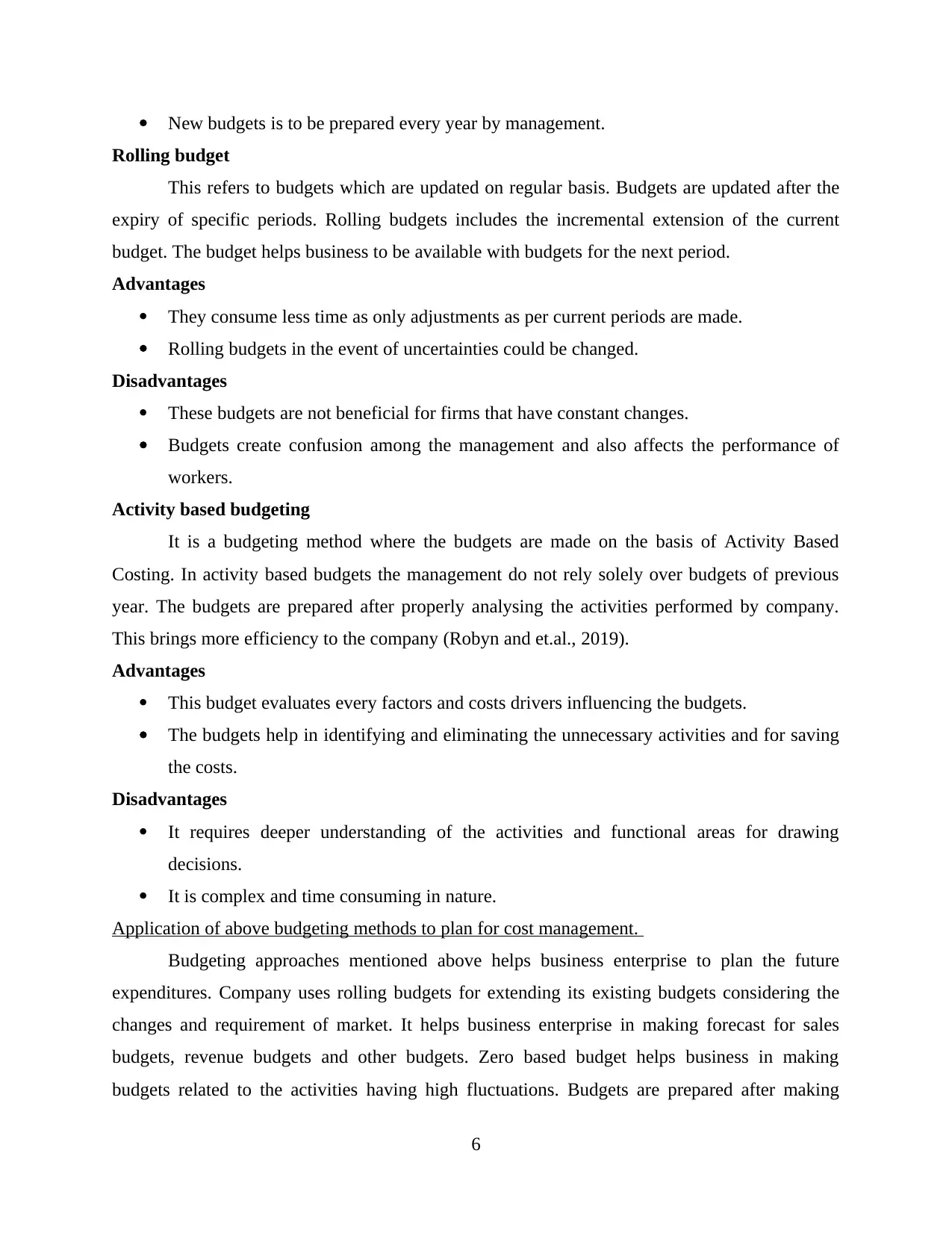
New budgets is to be prepared every year by management.
Rolling budget
This refers to budgets which are updated on regular basis. Budgets are updated after the
expiry of specific periods. Rolling budgets includes the incremental extension of the current
budget. The budget helps business to be available with budgets for the next period.
Advantages
They consume less time as only adjustments as per current periods are made.
Rolling budgets in the event of uncertainties could be changed.
Disadvantages
These budgets are not beneficial for firms that have constant changes.
Budgets create confusion among the management and also affects the performance of
workers.
Activity based budgeting
It is a budgeting method where the budgets are made on the basis of Activity Based
Costing. In activity based budgets the management do not rely solely over budgets of previous
year. The budgets are prepared after properly analysing the activities performed by company.
This brings more efficiency to the company (Robyn and et.al., 2019).
Advantages
This budget evaluates every factors and costs drivers influencing the budgets.
The budgets help in identifying and eliminating the unnecessary activities and for saving
the costs.
Disadvantages
It requires deeper understanding of the activities and functional areas for drawing
decisions.
It is complex and time consuming in nature.
Application of above budgeting methods to plan for cost management.
Budgeting approaches mentioned above helps business enterprise to plan the future
expenditures. Company uses rolling budgets for extending its existing budgets considering the
changes and requirement of market. It helps business enterprise in making forecast for sales
budgets, revenue budgets and other budgets. Zero based budget helps business in making
budgets related to the activities having high fluctuations. Budgets are prepared after making
6
Rolling budget
This refers to budgets which are updated on regular basis. Budgets are updated after the
expiry of specific periods. Rolling budgets includes the incremental extension of the current
budget. The budget helps business to be available with budgets for the next period.
Advantages
They consume less time as only adjustments as per current periods are made.
Rolling budgets in the event of uncertainties could be changed.
Disadvantages
These budgets are not beneficial for firms that have constant changes.
Budgets create confusion among the management and also affects the performance of
workers.
Activity based budgeting
It is a budgeting method where the budgets are made on the basis of Activity Based
Costing. In activity based budgets the management do not rely solely over budgets of previous
year. The budgets are prepared after properly analysing the activities performed by company.
This brings more efficiency to the company (Robyn and et.al., 2019).
Advantages
This budget evaluates every factors and costs drivers influencing the budgets.
The budgets help in identifying and eliminating the unnecessary activities and for saving
the costs.
Disadvantages
It requires deeper understanding of the activities and functional areas for drawing
decisions.
It is complex and time consuming in nature.
Application of above budgeting methods to plan for cost management.
Budgeting approaches mentioned above helps business enterprise to plan the future
expenditures. Company uses rolling budgets for extending its existing budgets considering the
changes and requirement of market. It helps business enterprise in making forecast for sales
budgets, revenue budgets and other budgets. Zero based budget helps business in making
budgets related to the activities having high fluctuations. Budgets are prepared after making
6
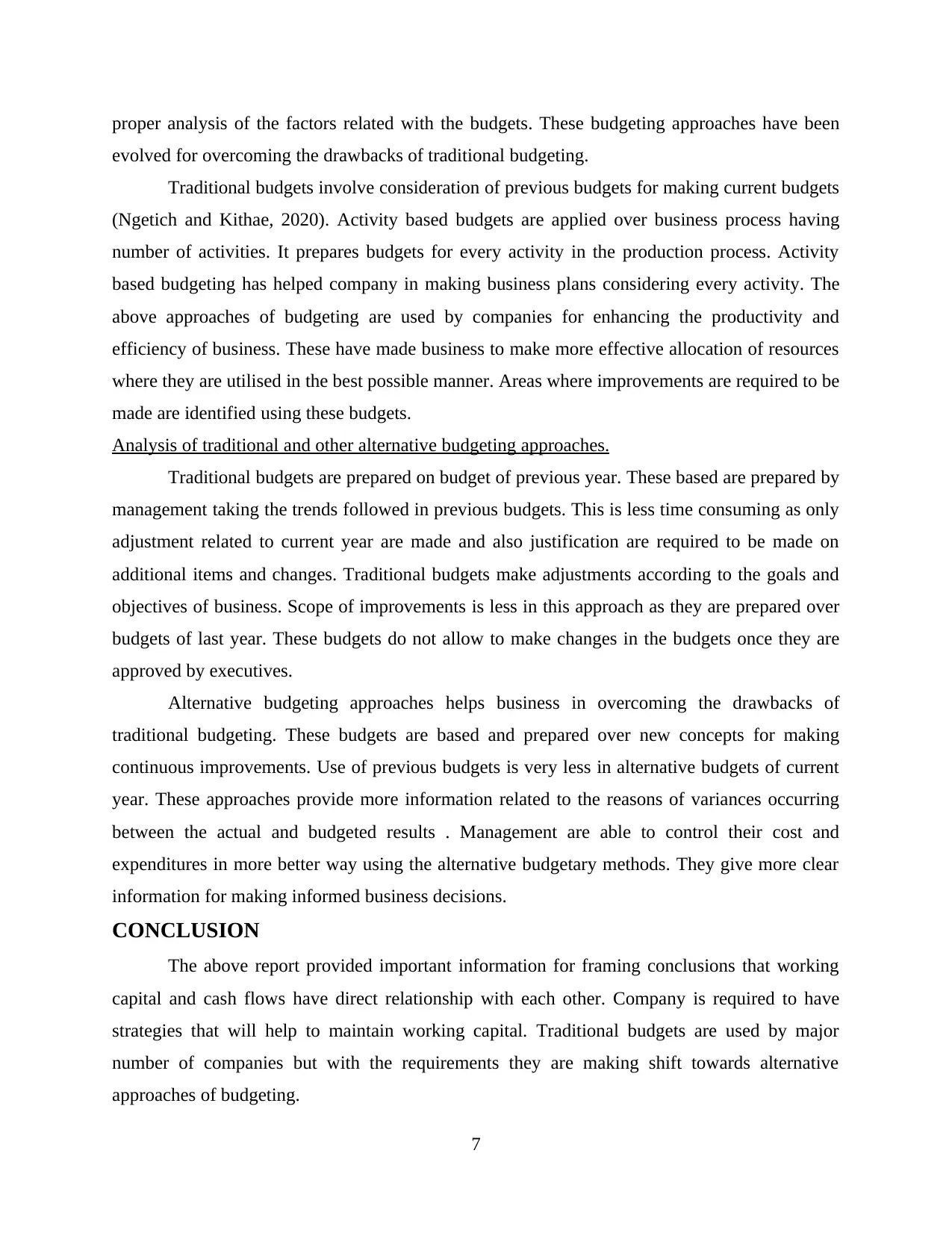
proper analysis of the factors related with the budgets. These budgeting approaches have been
evolved for overcoming the drawbacks of traditional budgeting.
Traditional budgets involve consideration of previous budgets for making current budgets
(Ngetich and Kithae, 2020). Activity based budgets are applied over business process having
number of activities. It prepares budgets for every activity in the production process. Activity
based budgeting has helped company in making business plans considering every activity. The
above approaches of budgeting are used by companies for enhancing the productivity and
efficiency of business. These have made business to make more effective allocation of resources
where they are utilised in the best possible manner. Areas where improvements are required to be
made are identified using these budgets.
Analysis of traditional and other alternative budgeting approaches.
Traditional budgets are prepared on budget of previous year. These based are prepared by
management taking the trends followed in previous budgets. This is less time consuming as only
adjustment related to current year are made and also justification are required to be made on
additional items and changes. Traditional budgets make adjustments according to the goals and
objectives of business. Scope of improvements is less in this approach as they are prepared over
budgets of last year. These budgets do not allow to make changes in the budgets once they are
approved by executives.
Alternative budgeting approaches helps business in overcoming the drawbacks of
traditional budgeting. These budgets are based and prepared over new concepts for making
continuous improvements. Use of previous budgets is very less in alternative budgets of current
year. These approaches provide more information related to the reasons of variances occurring
between the actual and budgeted results . Management are able to control their cost and
expenditures in more better way using the alternative budgetary methods. They give more clear
information for making informed business decisions.
CONCLUSION
The above report provided important information for framing conclusions that working
capital and cash flows have direct relationship with each other. Company is required to have
strategies that will help to maintain working capital. Traditional budgets are used by major
number of companies but with the requirements they are making shift towards alternative
approaches of budgeting.
7
evolved for overcoming the drawbacks of traditional budgeting.
Traditional budgets involve consideration of previous budgets for making current budgets
(Ngetich and Kithae, 2020). Activity based budgets are applied over business process having
number of activities. It prepares budgets for every activity in the production process. Activity
based budgeting has helped company in making business plans considering every activity. The
above approaches of budgeting are used by companies for enhancing the productivity and
efficiency of business. These have made business to make more effective allocation of resources
where they are utilised in the best possible manner. Areas where improvements are required to be
made are identified using these budgets.
Analysis of traditional and other alternative budgeting approaches.
Traditional budgets are prepared on budget of previous year. These based are prepared by
management taking the trends followed in previous budgets. This is less time consuming as only
adjustment related to current year are made and also justification are required to be made on
additional items and changes. Traditional budgets make adjustments according to the goals and
objectives of business. Scope of improvements is less in this approach as they are prepared over
budgets of last year. These budgets do not allow to make changes in the budgets once they are
approved by executives.
Alternative budgeting approaches helps business in overcoming the drawbacks of
traditional budgeting. These budgets are based and prepared over new concepts for making
continuous improvements. Use of previous budgets is very less in alternative budgets of current
year. These approaches provide more information related to the reasons of variances occurring
between the actual and budgeted results . Management are able to control their cost and
expenditures in more better way using the alternative budgetary methods. They give more clear
information for making informed business decisions.
CONCLUSION
The above report provided important information for framing conclusions that working
capital and cash flows have direct relationship with each other. Company is required to have
strategies that will help to maintain working capital. Traditional budgets are used by major
number of companies but with the requirements they are making shift towards alternative
approaches of budgeting.
7
You're viewing a preview
Unlock full access by subscribing today!
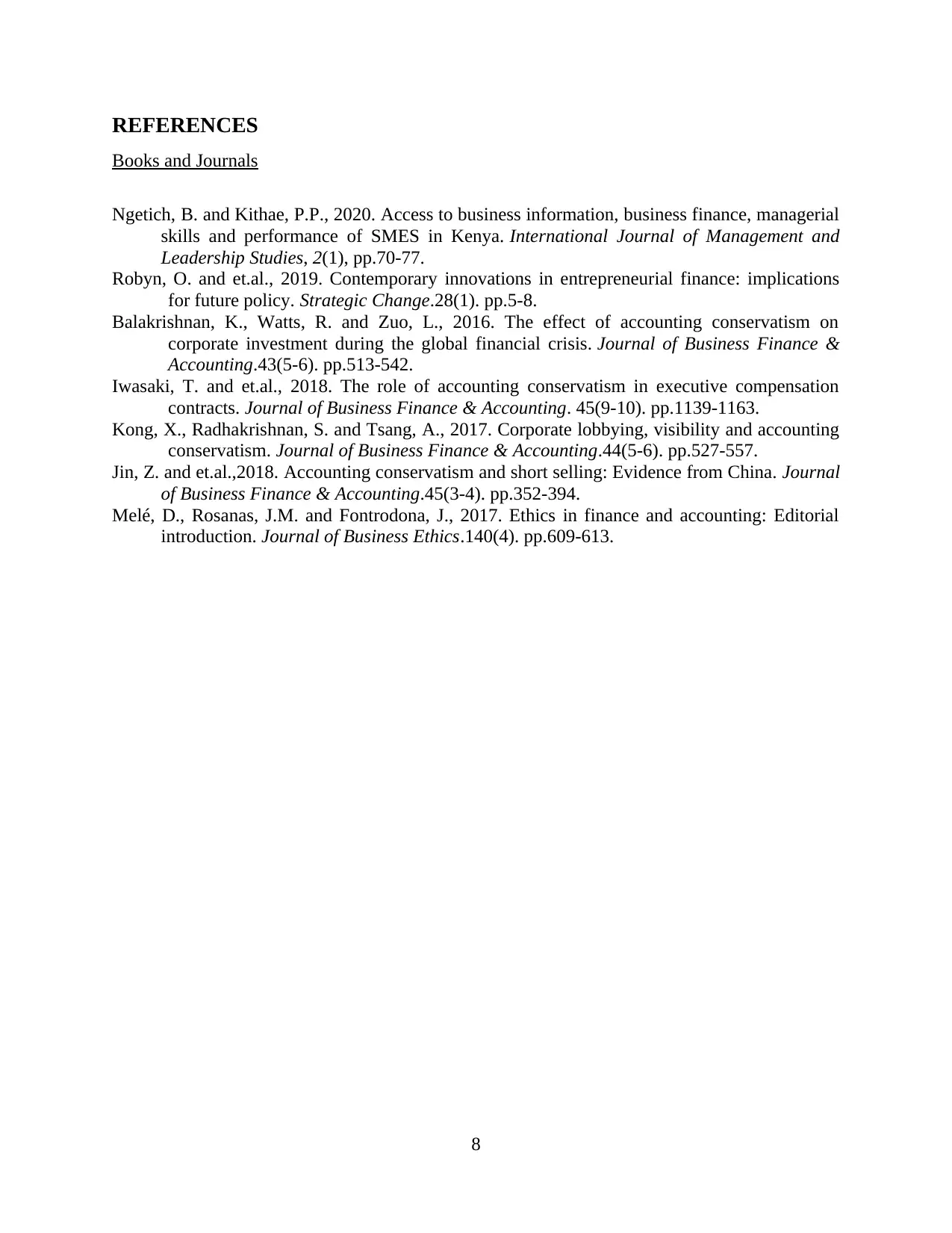
REFERENCES
Books and Journals
Ngetich, B. and Kithae, P.P., 2020. Access to business information, business finance, managerial
skills and performance of SMES in Kenya. International Journal of Management and
Leadership Studies, 2(1), pp.70-77.
Robyn, O. and et.al., 2019. Contemporary innovations in entrepreneurial finance: implications
for future policy. Strategic Change.28(1). pp.5-8.
Balakrishnan, K., Watts, R. and Zuo, L., 2016. The effect of accounting conservatism on
corporate investment during the global financial crisis. Journal of Business Finance &
Accounting.43(5-6). pp.513-542.
Iwasaki, T. and et.al., 2018. The role of accounting conservatism in executive compensation
contracts. Journal of Business Finance & Accounting. 45(9-10). pp.1139-1163.
Kong, X., Radhakrishnan, S. and Tsang, A., 2017. Corporate lobbying, visibility and accounting
conservatism. Journal of Business Finance & Accounting.44(5-6). pp.527-557.
Jin, Z. and et.al.,2018. Accounting conservatism and short selling: Evidence from China. Journal
of Business Finance & Accounting.45(3-4). pp.352-394.
Melé, D., Rosanas, J.M. and Fontrodona, J., 2017. Ethics in finance and accounting: Editorial
introduction. Journal of Business Ethics.140(4). pp.609-613.
8
Books and Journals
Ngetich, B. and Kithae, P.P., 2020. Access to business information, business finance, managerial
skills and performance of SMES in Kenya. International Journal of Management and
Leadership Studies, 2(1), pp.70-77.
Robyn, O. and et.al., 2019. Contemporary innovations in entrepreneurial finance: implications
for future policy. Strategic Change.28(1). pp.5-8.
Balakrishnan, K., Watts, R. and Zuo, L., 2016. The effect of accounting conservatism on
corporate investment during the global financial crisis. Journal of Business Finance &
Accounting.43(5-6). pp.513-542.
Iwasaki, T. and et.al., 2018. The role of accounting conservatism in executive compensation
contracts. Journal of Business Finance & Accounting. 45(9-10). pp.1139-1163.
Kong, X., Radhakrishnan, S. and Tsang, A., 2017. Corporate lobbying, visibility and accounting
conservatism. Journal of Business Finance & Accounting.44(5-6). pp.527-557.
Jin, Z. and et.al.,2018. Accounting conservatism and short selling: Evidence from China. Journal
of Business Finance & Accounting.45(3-4). pp.352-394.
Melé, D., Rosanas, J.M. and Fontrodona, J., 2017. Ethics in finance and accounting: Editorial
introduction. Journal of Business Ethics.140(4). pp.609-613.
8
1 out of 10
Related Documents
Your All-in-One AI-Powered Toolkit for Academic Success.
+13062052269
info@desklib.com
Available 24*7 on WhatsApp / Email
![[object Object]](/_next/static/media/star-bottom.7253800d.svg)
Unlock your academic potential
© 2024 | Zucol Services PVT LTD | All rights reserved.





